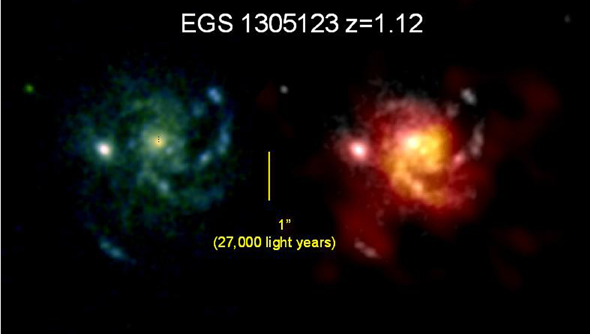News
Young galaxies gorge on gas
An international team of astronomers has used observations with the IRAM Plateau de Bure Interferometer to demonstrate that normal star forming galaxies a few billion years after the Big Bang had five to ten times more cold gas than today. With more “food” to fuel the star formation process, this provides a straightforward explanation for the higher star formation rates seen in early galaxies, when the Universe was still young.
|
|
| Spatially resolved optical and millimetre images of a typical massive galaxy at redshift z=1.1 (5.5 billion years after the Big Bang). The left image was taken with the Hubble Space Telescope. The right image is an overlay of the CO 3-2 emission observed with the PdBI (red/yellow colours) superposed on the I-image (grey). Credits: IRAM/MPE |
“We have been able, for the first time, to detect and image the cold molecular gas in normal star forming galaxies, which are representative of the typical massive galaxy populations shortly after the Big Bang” said Linda Tacconi from the Max Planck Institute for extraterrestrial Physics, who is the lead author of a paper in this week’s issue of Nature in which these results are presented.
The challenging observations yield the first glimpse how galaxies, or more precisely the cold gas in these galaxies, looked like a mere 3 to 5 billion years after the Big Bang (equivalent to a cosmological redshift z~2 to z~1). At this epoch, galaxies seem to have formed stars more or less continuously with at least ten times the rate seen in similar mass systems in the local Universe. The fundamental question is whether these large star formation rates were caused by larger reservoirs of cold molecular gas (which represents the ‘food’ for newly formed stars), or whether star formation in the young Universe was much more efficient than it is today.
Over the past decade astronomers have established a global framework of how galaxies formed and evolved when the Universe was only a few billion years old. Gas cooled and collected in concentrations of the mysterious ‘dark’ matter (so called dark matter halos). Over cosmological timescales, gas accreting from these halos onto the proto-galaxies, and collisions and mergers of galaxies subsequently led to the hierarchical build-up of galaxy mass. Detailed observations of the cold gas and its distribution and dynamics hold a key role in disentangling the complex mechanisms responsible for turning the first proto-galaxies into modern galaxies, such as the Milky-Way.
A major study of distant, luminous star forming galaxies at the Plateau de Bure millimetre interferometer has now resulted in a break-through by having a direct look at the star formation “food”. The study took advantage of major recent advances in the sensitivity of the receivers at the observatory to make the first systematic survey of cold gas properties (traced by a rotational line of the carbon monoxide molecule) of normal massive galaxies when the Universe was 40% (z=1.2) and 24% (z=2.3) of its current age. Previous observations were largely restricted to rare, very luminous objects, including galaxy mergers and quasars. The new study instead traces massive star forming galaxies representative of the ‘normal’, average galaxy population in this mass and redshift range.
“When we started the programme about a year ago”, says Dr. Tacconi, “we could not be sure that we would even detect anything. But the observations were successful beyond our most optimistic hopes. We have been able to demonstrate that massive normal galaxies at z~1.2 and z~2.3 had five to ten times more gas than what we see in the local Universe. Given that these galaxies were forming stars at a high rate over long periods of time, this means that gas must have been continuously replenished by accretion from the dark matter halos, in excellent agreement with recent theoretical work.”
Another important result of these observations are the first spatially resolved images of the cold gas distribution and motions in several of the galaxies (Figure). “This survey has opened the door for an entirely new avenue of studying the evolution of galaxies,” says Pierre Cox, the director of IRAM. “This is really exciting and there is much more to come.”
Francoise Combes, co-author of the study and a renowned expert in galaxy dynamics said: “These data are incredibly interesting. They clearly show the presence of large massive gas disks in the young galaxies. It appears that the efficiency of star formation in these disks was not unlike that in the local Universe. There was just so much more gas at that time, thus explaining the remarkable star formation rates that have puzzled us for a number of years”.
Notes:
The scientists involved in the study are:
N. Bouché, N.M. Förster Schreiber, R. Genzel, J.Gracia-Carpio, D. Lutz, L.J. Tacconi (all Max-Planck-Institute for Extraterrestrial Physics, Garching, Germany), P.Cox, R.Neri (IRAM, France), M.C.Cooper, B.Weiner (University of Arizona, USA), K.Shapiro, J.Comerford, M.Davis (University of California, Berkeley, USA), A.Bolatto (University of Maryland, USA), F.Bournaud (CEA, Gif-sur-Yvette, France), A.Burkert, T.Naab (University of Munich (LMU) and Excellence Cluster, Munich, Germany), F.Combes (Observatoire de Paris, France), S.Garcia-Burillo (Madrid Observatory (OAN), Madrid, Spain), A.Omont (Instiute d’Astrophysique, Paris, France), A.E. Shapley (University of California, Los Angeles, USA), A. Sternberg (Tel Aviv University, Israel). R.Genzel is also associated with the Physics Department at the University of California, Berkeley (USA).
Original article:
High molecular gas fractions in normal massive star forming galaxies in the young Universe by Linda Tacconi et al. (published in Nature, February 11, 2010)
Contacts
Pierre Cox
IRAM
300 rue de la Piscine
38406 St. Martin d’Hères
Tel. +33 (0)4 76 82 49 53
E-mail : coxatiram.fr
Karin Zacher
Public Relations Officer
IRAM
300 rue de la Piscine
38406 St. Martin d’Hères
Tel. +33 (0)4 76 82 21 03
E-mail: zacheratiram.fr




